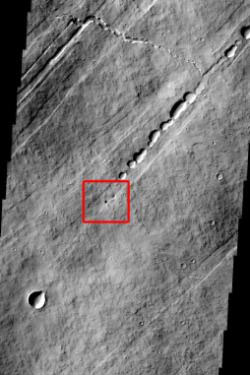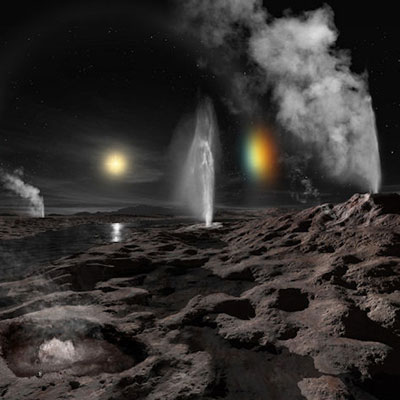 This week in Science Friday: Discover a new cave on Mars with a 7th grade science class, wake up with New Horizons half way to Pluto, endure the 10,000 kph wind storms on a badly named exoplanet, and see through concrete walls! All this and more, plus our gadget of the week: pointless spider robots!
This week in Science Friday: Discover a new cave on Mars with a 7th grade science class, wake up with New Horizons half way to Pluto, endure the 10,000 kph wind storms on a badly named exoplanet, and see through concrete walls! All this and more, plus our gadget of the week: pointless spider robots!
7th Graders Discover New Cave on Mars
A group of 16 students from a CA middle school discovered a new mysterious Martian cave recently while participating in the Arizona State University’s Mars Student Imaging Program. The program, housed in the same facility that looks over several scientific instruments operating on Mars, allows students to frame a science question and then target images of the Martian surface using the THEMIS camera aboard the Mars Odyssey orbiter to answer their question. The image taken by students from Dennis Mitchell’s 7-th grade science class revealed what appears to be a Martian skylight – a hole in the roof of a cave on Mars. The feature is similar to that observed previously by USGS scientist Glen Cushing. “This pit is certainly new to us,” Cushing told the students. “And it is only the second one known to be associated with Pavonis Mons.” The skylights are thought to be associated with volcanic activity on the Red Planet. To learn more about the Mars Student Imaging Program, visit http://msip.asu.edu.

The newly discovered skylight on Mars
Halfway to Pluto, New Horizons Readies for 2015 Flyby
Now over halfway to its icy destination, New Horizons, the first spacecraft to ever travel to the now non-planet of Pluto, woke up for the first time in months to prep its instruments for its eventual meeting with the small icy body in 2015. “We don’t want to miss a single breathtaking moment during the Pluto encounter,” says a New Horizons project scientist. “So we’re checking everything out now to make sure we’re ship-shape and ready to go.” Zipping through space at roughly a million miles per day, New Horizons is one of the fastest spacecraft ever sent into space. That means that we will have very little time while flying by the planet, so the instruments need to be ready to shift into full gear when the time comes. It is hard to prepare to measure what is a completely mysterious world, and scientists don’t know what to expect upon arrival. “During a flyby of Neptune in 1989, Voyager 2 spotted dark streaks on Neptune’s moon Triton that appear to have been produced by geysers spewing dirty, frozen nitrogen particles. We could see something similar on Pluto.” But, at this point, it’s anyone’s guess.

Concept art of just one possibility for what we will see on Pluto in 2015
Exostorm on HD209458b (aka Ceti Alpha V?)
Astronomers have made the first measurements of a raging storm on an exoplanet: the “hot Jupiter” known as HD209458b. While the name might not be catchy, HD’s claim to fame is its super wind, blowing at an estimated speed of 5,000 to 10,000 km per hour! The measurements were made by observing the toxic carbon monoxide gas in HD’s atmosphere. HD209458b is an exoplanet of about 60% the mass of Jupiter orbiting a solar-like star located 150 light-years from Earth towards the constellation of Pegasus (the Winged Horse). Circling at a distance of only one twentieth the Sun-Earth distance, the planet is heated intensely by its parent star, and has a surface temperature of about 1000 degrees Celsius on the hot side. But as the planet always has the same side to its star, one side is very hot, while the other is much cooler. Certainly not a planet for the faint of heart. May I suggest a name change to Ceti Alpha V? (Bonus: even more exoplanet news! Six New Planets Discovered)

“This IS Ceti Alpha V!”
Translucent Concrete Walls Defy Logic
Oh no, is Scotty messing with the timeline again? First transparent aluminum, and now transparent concrete! Well, translucent at least. An architect in Tokyo has been showing off his latest invention, which uses fiber optic tubes embedded in concrete to allow one to see silhouettes of people on the other side of a concrete wall. The plastic fibers are placed throughout the concrete, built in a stratified process that looks a lot like lasagna. First demonstrated last year, it’s now featured in a new installation at Israel’s Design Museum Holon. The material makes for a pretty trippy effect. See for yourself in the video below!
Nature is Crazy! of the Week: Creepy Spider Crab
If you thought spider crabs couldn’t get any creepier, think again. Check out this video, which shows a spider crab shed its skin in one fluid motion to emerge as a gigantic, even creepier spider crab! Fascinating.
Gadget of the Week: Pointless Spider Robots
The spider crab not spider-y enough for you? How about this ridable spider robot? This is the kind of invention that really makes you ask, “why?”. Do we really want to be riding these 4-legged freaks down the freeway to work every morning? If that’s the future, count me out.
#FollowFriday
If you are on Twitter, you know there are plenty of amazing people out there tweeting away. And, many of them are scientists! Every Friday I’ll be bringing you a new list of great scientists, techies, and trekkies to follow on Twitter. This week…
- @esamarswebcam: The Visual Monitoring Camera (VMC) is mounted on Mars Express, ESA’s deep-space probe now orbiting the Red Planet.
- @JeriLRyan: Voyager actress of 7-of-9 fame. Actress, wife, mom, foodie, and gardener. Not necessarily in that order.
- @boborci: Bob Orci. The man that needs to introduction.
Science Quickies
Not enough science for you? Here’s a warp-speed look at some more science tid-bits that are worth a look.
- This weekend, see a big lunar eclipse
- New particle accelerator on the block: the SLAC linear collider in Menlo Park, CA
- Lab engineered tissue living on rats
TrekMovie’s Science Friday is an homage the the great NPR radio show Science Friday. Science Friday® is a registered service mark of ScienceFriday Inc.

As a former science classroom teacher I can really appreciate that story about the 7th graders and their find. Good for them!
I think I’ll ask my local GYM if they can install those new walls between the men’s and women’s dressing rooms!!
#2
So everyone can watch you take a cold shower?
Great article again, Kayla!
That crab video reminds me of just one thing:
“The whole system was infested with Talerian hook spiders.”
“It was the hardest thing I’ve ever done, but I let the damned array blow up!”
(yes, I know – I’m just filling in what *I* would have said in Miles O’Brien’s place.)
1000 Celcius, 10,000 kph winds? Of course, it’s the humidity that’ll kill ya.
Pluto in 2015? At least American robots will still be having some fun up there.
Bob Orci, why are you disguised as Fidel Castro on your Twitter page?
Thanks, Kayla!
No that planet cannot be Ceti Alpha V, too close to its star. It could be Excalbia maybe, it didn’t have the wind but if I remember it not a prime vacation spot..
I REALLY want to see the inside of those Martian caves!
What’s wrong with the Henry Draper Catalogue of Stellar Spectra #209458, 2nd most massive object, also non-stellar (thus ‘b’ not ‘B’)??
Let’s save our whimsical naming for objects in our own solar system, and leave other systems to future generations? :) Or the residents of those other systems!
I could have gone me whole life knowing that creepy spider crab didn’t exist!
The translucent concrete is interesting, maybe, but there’s really no point to it (short of the “cool” factor) that I can see.
Same goes for that spider robot thingy…but it’s got a much lower “cool” factor.
“This IS Ceti Alpha V!”
LOL.
If the vast number of Star Trek episodes where the action happens inside a cave is any indication, I’ll bet if Mars has anything interesting to offer, it’s INSIDE THAT CAVE!
Scott B. out.
P.S. It’s a shame New Horizons is a fly-by, and won’t be orbiting Pluto/Charon for a while … but I guess that would be tough to engineer.
Nast nasty nasty spider-crab thing.
Kayla is still my fav pretty trippy effect. }:-D>
So now the question is: Who put those caves up there and why?
LOL